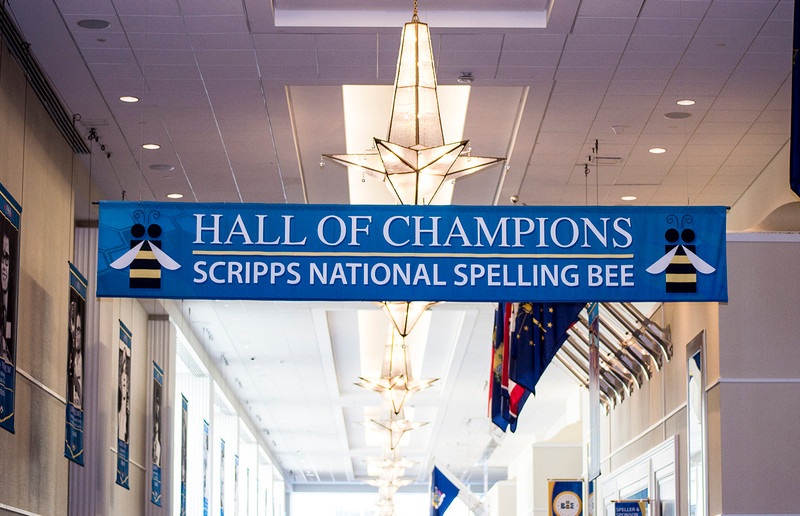As early as 1908, the National Education Association kicked around the idea of creating a national spelling bee for United States students. However, this idea did not come to fruition, and it was not until 1925 that the Louisville Courier-Journal, sponsor of Kentucky's statewide bee, contacted other bee sponsors and pulled together the framework for a national event. The coordinated series of competitions that the Courier-Journal and eight other newspapers established drew a staggering two million participants at the local level during its first year. Students who advanced traveled to Washington D.C. to participate in the championship contest.
That year, Frank Neuhauser, an 11-year-old boy from Louisville, won the first national spelling bee, $500, and an opportunity to meet President Calvin Coolidge. The word that garnered him the victory? "Gladiolus." The following year, another Louisville-sponsored student , Pauline Bell , won the championship. Her winning word? "Cerise."
The competition grew throughout the 1920's and 1970's, despite a three-year hiatus during World War II. In 1941, a newspaper conglomerate called the E.W. Scripps Company (est. 1879) took the reins and became the contest's new sponsor. As Scripps evolved to become a large-scale media conglomerate, the National Spelling Bee evolved with it.The first live, televised broadcast of the final round occurred in 1946 on NBC. The bee partnered with Merriam-Webster in 1958, around the same time that the dictionary emerged as "the official arbiter of a word's spelling."
Between 1980 and 1990, the number of spelling bee contestants doubled. Most recent growth has resulted from large-scale media coverage on ESPN, beginning in 1994. Interestingly enough, winners of international regional bees have also begun to enter the contest. The first champion who was not American was Jody-Anne Maxwell of Jamaica in 1998.
In 2013, Arvind Mahankali, a 13-year-old boy from New York, won the 86 th national spelling bee, $32,500, and access to a plethora of reference material. The word that nabbed him the trophy? "Knaidel." The following year, Sriram Hathwar of New York and Ansun Sujoe of Texas tied, sharing the championship title, an occurrence that has only happened four times in the contest's history.
As the stakes, amount of participants, and media coverage of the competition have risen, the spelling bee has emerged as a facet of popular culture. Spellbound, a 2002 documentary, followed eight spelling contestants during the year after the 1999 National Bee. Jeff Blitz, producer, contacted Hexco for recommendations of spellers to consider following, thus several were featured in the film were loyal Hexco customers. This documentary not only won an Emmy for Cultural/Artistic Programming, but was also named #4 on the International Documentary Association's list of the Top Documentaries of All Time in 2007. In 2006, Myra Goldberg's novel Bee Season (2000) was adapted into a movie titled Akeelah and the Bee, starring actress Keke Palmer. Other memorable spelling bee-related works include The 25th Annual Putnam County Spelling Bee, a comedic musical that appeared on Broadway itself, and Bad Words, a 2013 film starring Jason Bateman.
It is important to recognize that, as the competition has progressed, the difficulty level of material expected of participants has risen. The ever-evolving contest is fiercely competitive and stands as "…the nation's largest, most successful and longest-running educational program."
When Valerie, daughter of Hexco president Linda Tarrant, studied for her first school spelling bee in 1982, she began entering words, definitions, and pronunciations in her TRS/80 home computer. After her first trip to the Regional Bee the next year, she recognized that all spellers could benefit from her computer notes. There were no study aids for the contest, only the immensely large Webster's Third New International Dictionary. It was with that thought in mind that she created Valerie's Spelling Bee Supplement , and the business was born .The Supplement was followed by Huntley's Spelling Mentor software, which made learning easier. Additional products were added for teachers to conduct bees and then for students to learn etymology. Ultimately, Hexco produced products for advanced spellers to learn volumes of difficult words in printed format, computer-driven software, and Internet-driven systems.
Since 2000, every National Spelling Bee champion has used Hexco products.
Resources:
http://www.britannica.com/EBchecked/topic/1717364...
http://www.nytimes.com/2011/03/23/us/23neuhauser....
http://mentalfloss.com/article/56964/26-facts-abo...
http://www.britannica.com/EBchecked/topic/1717364...
http://spellingbee.com/history
http://www.cnn.com/2013/05/30/us/spelling-bee/
http://www.cnn.com/2014/05/29/living/national-spe...
http://www.nytimes.com/2011/03/23/us/23neuhauser....

